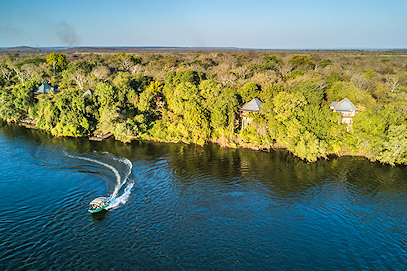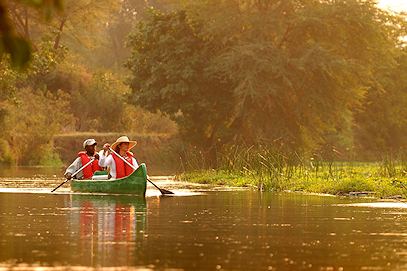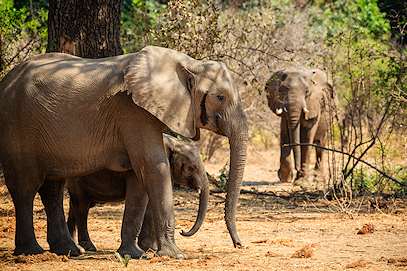Zambia's Lower Zambezi National Park
Help Me Plan- Home
- >
- African Travel
- >
- Zambia
- >
- Lower Zambezi National Park
Lower Zambezi National Park Destination Guide
Lower Zambezi National Park protects a wild valley along the northern bank of the Zambezi River, opposite Zimbabwe’s Mana Pools. Its escarpment and fertile floodplains draw abundant wildlife, with especially memorable elephant and predator viewing. Canoeing, boating, guided walks, and game drives offer varied ways to experience this remote river wilderness.
Getting to Lower Zambezi National Park
By Air: Upon arrival at OR Tambo International in Johannesburg, guests are welcomed and assisted in transferring to their flight to Lusaka, Zambia. A short two-hour flight will take you to Kenneth Kaunda International Airport. Once in Lusaka, guests fly directly to the Chiawa Game Management Area, conveniently located adjacent to the Lower Zambezi.
By Road: The park is approximately 150 km from Lusaka, and although it is accessible by road, the drive can take up to four hours. Guests on an African Sky safari are chartered directly to the park and transported privately to their lodge. Guests can rest assured that they are in the skillful hands of an expert ranger.
Weather & Best Time To Visit
From June to October, the dry season is the best time to visit the Lower Zambezi National Park for wildlife viewing and clear skies. Some camps inside the park close in the wet season due to access, while several in the surrounding GMA stay open. Birding is excellent in the rains when migrants arrive and vegetation turns lush.
During the wet season, the park is lovely, with vegetation becoming a lush green and flowers blossoming. It is the best time for birders to visit the area as the breeding season gets underway, and many newborn antelope grace the floodplains.

The lodges in the park allow you to choose day-long canoe trips or a leisurely hour on the river. You will meet a variety of animal and bird species on bush walks while engaging in animal tracking. Game viewing is best between June and October. Many camps close during the heavy rains, although some options in nearby areas remain open.
Reasons to visit Lower Zambezi National Park
Boat Life
Boating along the Zambezi River with magnificent views and proximity to hippo and crocodile is unforgettable. Riverine vegetation shelters smaller wildlife and birds, so there is always something to watch from the water.
Eye of the Tiger (fish)
The Zambezi River is synonymous with tigerfish. If you want a safari that pairs classic game viewing with a serious angling challenge, you’ve found it. Lodges can arrange tackle and gear so you can focus on the fight.
Swimming Cats
It’s possible to watch lion swim between channels or to islands in the Lower Zambezi. Seeing big predators in the water is rare elsewhere and adds to the park’s drama along the river.
Experiences to Savor
Visiting the Lower Zambezi is about indulging in the spoils of the prolific Zambezi River—whether you are gliding across the surface, fishing from its rich waters, or admiring the wildlife drawn to its banks.

Fishing
All the Lower Zambezi National Park lodges cater to fishing, with rods and tackle provided by the safari camps. Making your way to the banks of the Zambezi River, where anglers from all over the world come to catch tigerfish, is exhilarating.
Relax on the River
One of the best experiences is climbing into a canoe and drifting down the river, taking in the beautiful surroundings, then being picked up by a speedboat at the end of the day and taken back to camp—effortless and serene.
No Fences
There are no fenced camps in Lower Zambezi, which adds to the naturalness of the terrain and the excitement of staying in the park. Animals wander through lodge sites regularly, and you never know what you’ll find outside your door.Useful Information
History
Lower Zambezi is one of the youngest national parks in Zambia, established in 1983. Until then, it was the private nature reserve of Zambia’s president. The Cumings family later brought the first tourists into the park at Chiawa Camp in 1990. Over the last three decades, development has been measured and sensitive.
The valley needed some infrastructure to provide visitors access to its natural wealth. Airstrips and camps were established, and access routes opened. Today, fishing within regulations and community relationships in the broader GMA remain important parts of the park’s story.
Wildlife
The lush, pristine wilderness encompassing Lower Zambezi supports high densities of wildlife. Elephant herds of a hundred or more often gather on the floodplains, and large buffalo groups are common. The park holds healthy populations of impala, kudu, eland, wildebeest, waterbuck, and bushbuck, with chances of duiker or grysbok. Large numbers of hippo and crocodile inhabit the river.
The Big Five—except the rhinoceros—can be found in Lower Zambezi. Leopard and lion are regularly encountered along the riverine floodplain, and spotted hyena and African wild dog occur, taking advantage of the area’s abundant prey.
Vegetation & Terrain
The Zambezi Valley was shaped by ancient tectonic and volcanic activity, creating the dramatic escarpment and the broad river channel. Along the river are thick belts of riverine woodland and tall ebony, leadwood, and fig. North from the river, vegetation grades to floodplains, with mopane forests and miombo woodlands on higher ground and ridges.
Acacias and winterthorn trees are common, and the short grasses make for excellent guided walks. Floodplains provide grazing throughout the year; in the dry winter, wildlife concentrates along these green corridors. Giant baobabs and acacia are enduring symbols of the park.
Activities
Lower Zambezi National Park offers a variety of game-viewing experiences. Daily game drives in 4x4 vehicles with experienced rangers cover the lush plains and higher ground. Bush walks are led by armed game rangers and allow guests to explore habitats up close. Boat rides on the Zambezi reveal hippo and crocodile at eye level, and canoeing offers a quiet vantage point along channels.
If you enjoy fishing, the feisty tigerfish is found along the river and offers a great challenge (fishing is strictly catch-and-release in the park). Bird enthusiasts will be impressed by the multitude of species. The African fish eagle is common, and photographers find superb light over water and floodplains. Guests can also relax at their lodge with pool time or a spa treatment.









